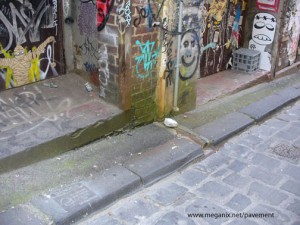When I need a laugh I pull out my copy of Unreliable Memoirs by Australian ex-patriot polymath Clive James. The whole book is funny but one of my favourite passages involves concrete footpaths, billy carts and rubber tyre marks. Oh, and poppies.
The pavement often appears in people’s reminiscences of childhood. This is not remarkable, especially if they lived in inner city areas when they were young. After all, children are close to the pavement and playing on it is an everyday experience – or at least it was when children had more freedom. There were games like hopscotch and chalk chase that needed to be marked out on the hard surface, rhymes and chants about avoiding the cracks (or break your mother’s back), and hot sticky bitumen roads that were torture to cross in bare feet in the summertime.
Even in the sprawling suburbs where spacious backyards were the norm, streets served as a communal playground for ball games and competitive races that could only be staged on paved surfaces. Clive James played with neighbourhood kids on the footpaths of Kogarah, a suburb of Sydney.
James has been in the news lately. He is suffering from a terminal illness and The New Yorker has published an emotional new poem written by him as he contemplates his death. Also this fortnight there has been the two-part documentary Brilliant Creatures: Germaine, Clive, Barry and Bob on ABC-TV. So as a tribute to him I reproduce here an excerpt that introduces the episode of the billycarts and poppies. If you haven’t already read the book – or even if you have – I recommend you track down a copy.
Other children, most of them admittedly older than I, but some of them infuriatingly not, constructed billycarts of advanced design, with skeletal hard-wood frames and steel-jacketed ball-race wheels that screamed on the concrete footpaths like a diving Stuka. The best I could manage was a sawn-off fruit box mounted on a fence-paling spine frame, with drearily silent rubber wheels taken off an old pram … Carts racing down the footpath on the far side had a straight run of about a quarter of a mile all the way to the park … Carts racing down the footpath on the near side could only go half as far, although nearly as fast, before being faced with a right-angle turn into Irene Street. Here a pram-wheeled cart like mine could demonstrate its sole advantage. The traction of the rubber tyres made it possible to negotiate the corner in some style. I developed a histrionic lean-over of the body and a slide of the back wheels which got me round the corner unscathed, leaving black smoking trails of burnt rubber.
Clive James, Unreliable memoirs, London: Picador, 1981.
The billycart photograph is in the collection of Museum Victoria. Reg. No: MM 110102
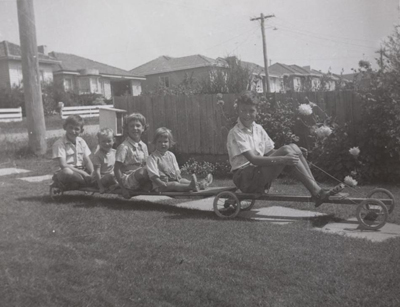






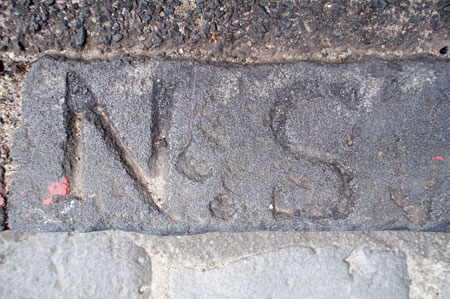


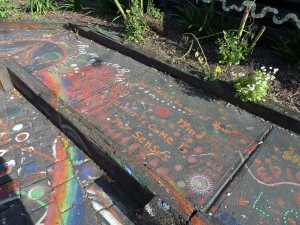

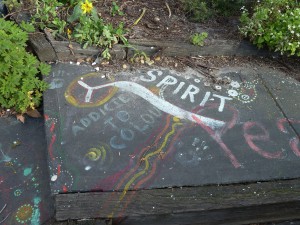



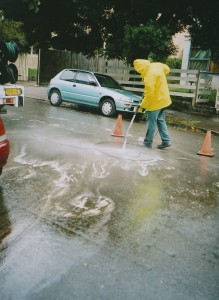
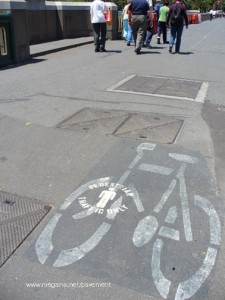 There is an ongoing battle between cyclists and just about everyone else – motorists don’t want them on the roads, pedestrians (like me) don’t want them on the footpaths. The issue is a perennial filler for Sydney newspapers and has flared again this week in news stories, opinion pieces and letters to the editor.
There is an ongoing battle between cyclists and just about everyone else – motorists don’t want them on the roads, pedestrians (like me) don’t want them on the footpaths. The issue is a perennial filler for Sydney newspapers and has flared again this week in news stories, opinion pieces and letters to the editor.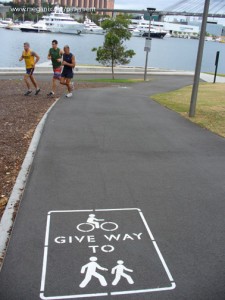 Almost every sign, symbol, graphic and graffiti marked on the roads and sidewalks is a claim for territory. The two examples photographed for today’s blog record instances where pedestrians have had a victory over cyclists, officially at least, and probably only temporarily. The ineptly obliterated bicycle symbol overpainted with a ‘Pedestrian traffic only’ stencil was on the bridge at the corner of St Kilda Road and Flinders Street in Melbourne in 2005. The ‘Give way’ stencils appeared in parks in the City of Sydney towards the end of 2008 after many complaints from pedestrian park-users.
Almost every sign, symbol, graphic and graffiti marked on the roads and sidewalks is a claim for territory. The two examples photographed for today’s blog record instances where pedestrians have had a victory over cyclists, officially at least, and probably only temporarily. The ineptly obliterated bicycle symbol overpainted with a ‘Pedestrian traffic only’ stencil was on the bridge at the corner of St Kilda Road and Flinders Street in Melbourne in 2005. The ‘Give way’ stencils appeared in parks in the City of Sydney towards the end of 2008 after many complaints from pedestrian park-users.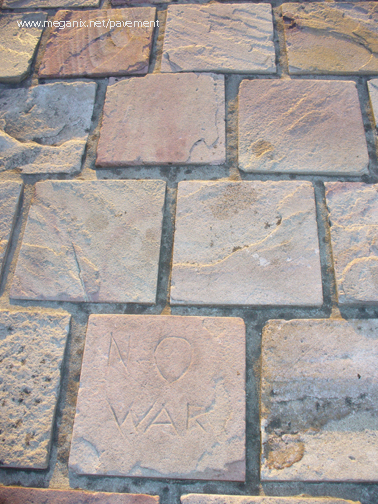 At Federation Square in Melbourne Nearamnew is a public artwork that incorporates the cobblestone paving. According to the
At Federation Square in Melbourne Nearamnew is a public artwork that incorporates the cobblestone paving. According to the 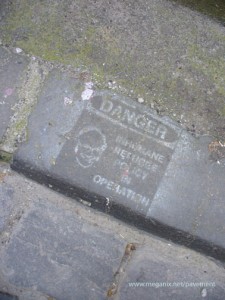 Even if you weren’t a graffiti aficionado you would probably recognize that this is somewhere in Melbourne because of the bluestone cobbles. It’s Hosier Lane in November 2005. Amongst the different styles of wall graffiti there is one stencil on the kerbstone. ItÂ
Even if you weren’t a graffiti aficionado you would probably recognize that this is somewhere in Melbourne because of the bluestone cobbles. It’s Hosier Lane in November 2005. Amongst the different styles of wall graffiti there is one stencil on the kerbstone. It 